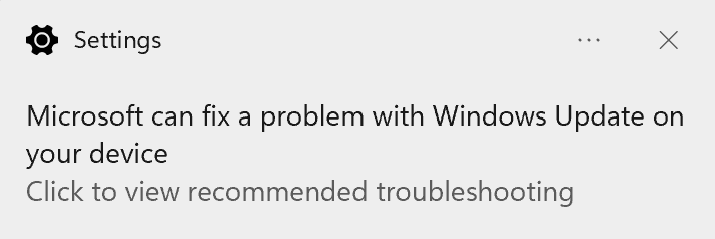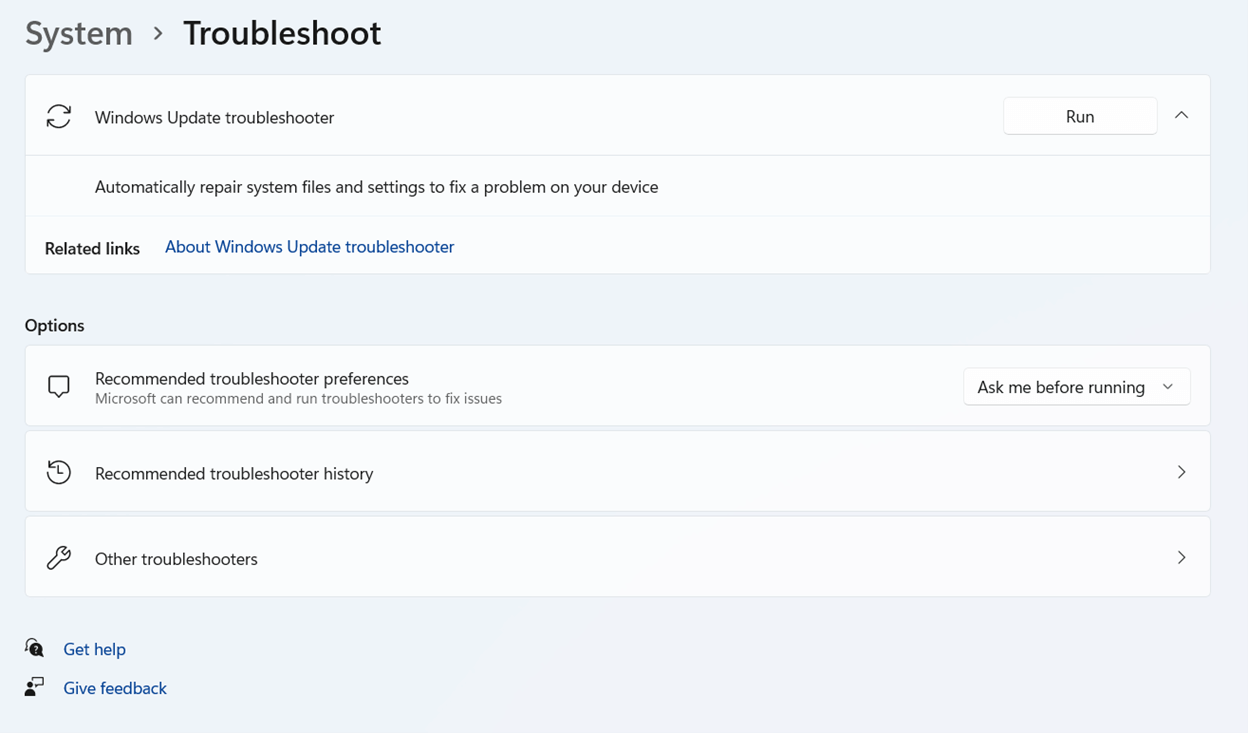In current Windows 11 builds, we'll automatically fix certain critical problems on your Windows device to keep it running smoothly.
We’ll also recommend troubleshooting for other problems that aren’t critical to normal Windows operation but might impact your experience. Unlike critical troubleshooters, recommended ones may change a setting you’ve personalized, so we’ll ask for your permission first.
Critical troubleshooting
Critical troubleshooting will automatically fix things like corrupt settings that keep critical services from running, make adjustments to work with your hardware, or make other specific changes required for Windows to operate with the hardware, apps, and settings you’ve selected. These are changes you won’t notice. Critical troubleshooting happens automatically and can’t be turned off.
Recommended troubleshooting
Windows 11 devices get recommended troubleshooting for problems we know about and problems found in diagnostic data sent to Microsoft. We might determine that a problem is impacting a specific set of devices based on Windows version information, user feedback, error information, device settings, hardware configuration, and device capabilities such as installed apps and drivers. We’ll let you know when we can help, and you can choose to run the troubleshooter or ignore it. You must be connected to the internet to use recommended troubleshooting.
There are two levels of diagnostic data: required and optional. Recommended troubleshooting works with either setting, but we might not be able to detect some problems on devices only sending required data. If you're only sending required data, you'll see the following message: "For more troubleshooters, share optional diagnostic data." For more information about diagnostic data and the differences between required and optional data, including how to change your selection, see diagnostics, feedback, and privacy in Windows.
For example, a feature might not work as designed in a specific version of Windows because of an incompatibility caused by a bug found after release. We’ll use diagnostic data to identify devices that:
-
Experience the crash
-
Have the specific version of Windows impacted by the bug installed
-
Have the incompatible app or driver installed
These devices will be offered Microsoft’s recommended troubleshooting for the problem, while other devices that aren’t experiencing the problem won’t. If it’s a critical problem, we’ll automatically run the troubleshooter to fix the problem, otherwise we’ll let you decide what to do.
Recommended troubleshooting settings
To change how recommended troubleshooting is run on your device, go to Start > Settings > System > Troubleshoot . Next, choose from the following options for "Recommended troubleshooter preferences":
-
Run automatically, don't notify me
Windows will automatically run recommended troubleshooters for problems detected on your device without bothering you. -
Run automatically, then notify me
Windows will tell you after recommended troubleshooters have solved a problem so you know what happened. -
Ask me before running (default)
We’ll let you know when recommended troubleshooting is available. You can review the problem and changes before running the troubleshooters. -
Don't run any
Windows will automatically run critical troubleshooters but won’t recommend troubleshooting for other problems. You will not get notifications for known problems, and you will need to manually troubleshoot these problems on your device.
Note: Devices enrolled in the Windows Insider Program can’t select “Only fix critical problems for me".
Recommended troubleshooting notifications
Windows 10 devices configured to “Ask me before running” will receive a notification when new troubleshooting is available.

Click or tap the notification to view the Troubleshoot settings page, where you can learn more about the problem and what the troubleshooter does. Select Run to start it immediately. If you don’t want to run the troubleshooter now, you can find it later by going to Start > Settings > System > Troubleshoot .

Troubleshooters that haven’t been run might be automatically removed from the list of recommended troubleshooting when they no longer apply to your device.
Troubleshooting history
Windows keeps track of the critical and recommended troubleshooting run on your device so you know what problems we’ve fixed. To find troubleshooting history, go to Start > Settings > System > Troubleshoot > Recommended troubleshooting history.

Devices configured to “Run automatically, then notify me” can click or tap the notification to view the troubleshooting history and learn more.

Troubleshooting history only tracks critical and recommended troubleshooters. Troubleshooting wizards, like “playing audio”, will not be shown in history.










